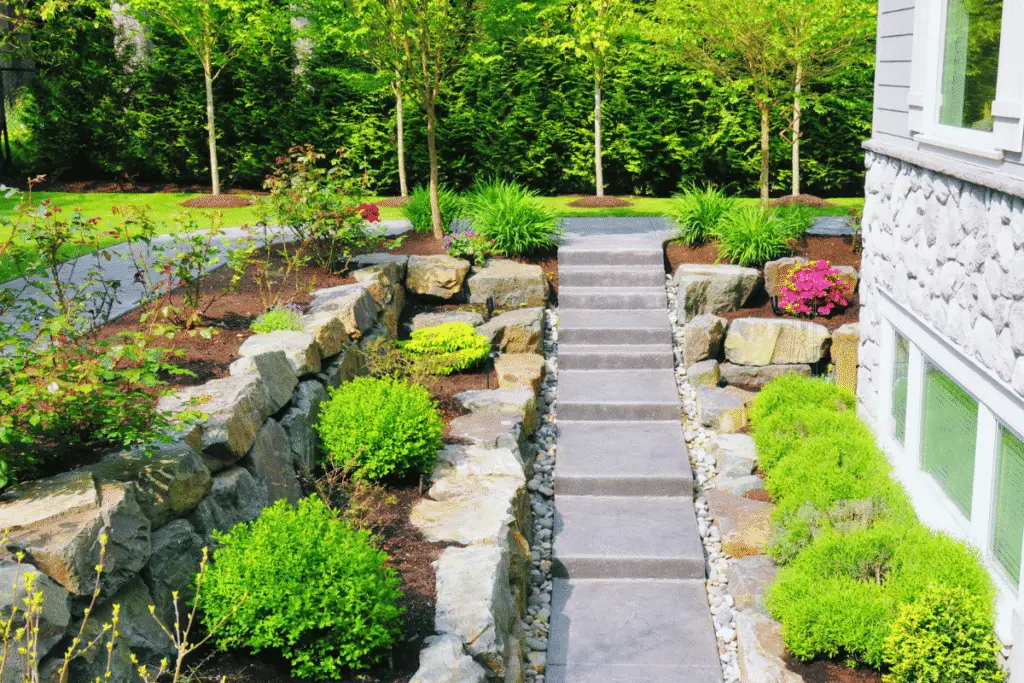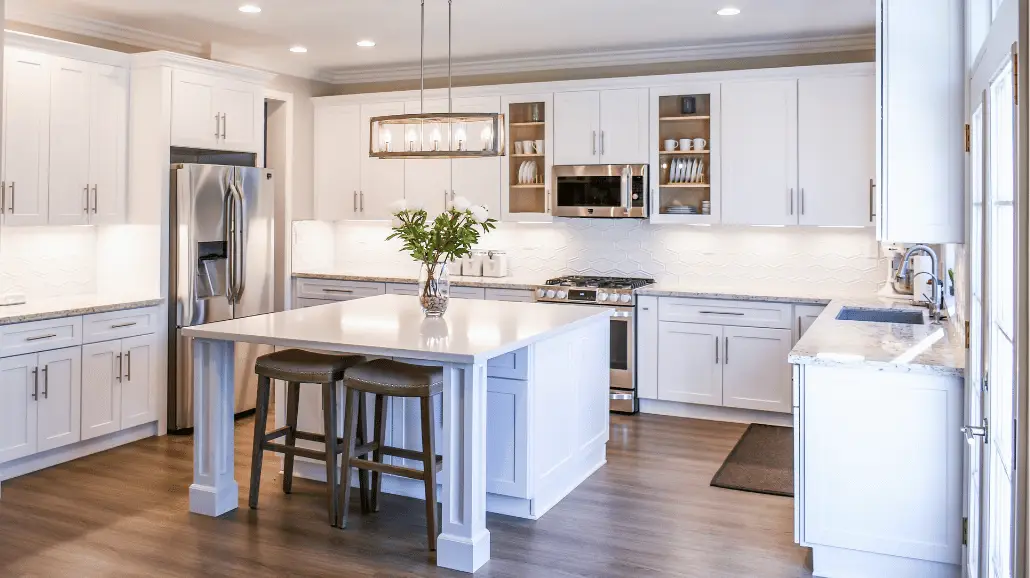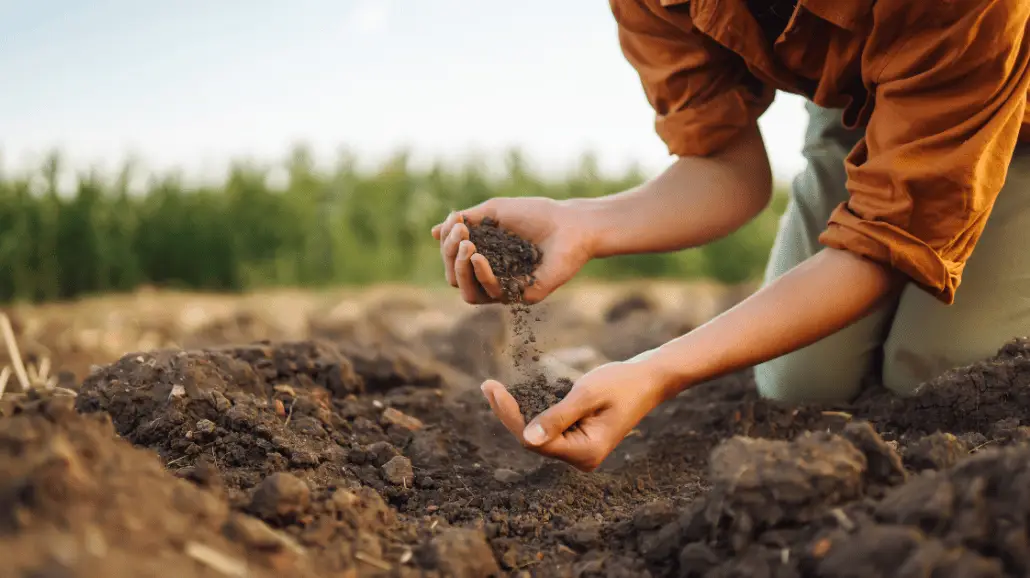Dreaming of a stunning landscape around your new custom home, but dread the thought of constant yard work? You’re not alone. Achieving a beautiful outdoor space in Boise without becoming a full-time gardener is entirely possible.
Key strategies for a low-maintenance landscaping plan include drought-tolerant plants, efficient watering, and smart design elements. Read on to learn more about turning your yard into an easy oasis.
1. Choose Drought-Tolerant Plants
Boise’s climate is characterized by hot, dry summers and relatively mild winters. Choosing plants naturally adapted to these conditions is crucial to a low-maintenance landscape. These plants require less supplemental watering, reducing both your water bill and the time you spend with a hose.
When planning a drought-tolerant garden, check the hardiness zone rating of each plant. Most of Treasure Valley is primarily located in USDA Hardiness Zone 7a. Selecting plants in this zone ensures they can withstand our winter climate without extra care or the need for overwintering indoors, a crucial aspect of a low-maintenance design.
Consider these fantastic drought-tolerant options that thrive in the Treasure Valley:
- Ornamental Grasses: Varieties like Feather Reed Grass (Calamagrostis x acutiflora ‘Karl Foerster’), Little Bluestem (Schizachyrium scoparium), and Fountain Grass (Pennisetum alopecuroides) offer beautiful textures and movement, require minimal watering once established, and provide year-round interest.
- Perennials: Many stunning perennials are well-suited to Boise’s climate. Consider Coneflowers (Echinacea), Black-Eyed Susans (Rudbeckia hirta), Lavender (Lavandula), Sedum (various species), and Yarrow (Achillea). These come in various colors and bloom times, attracting pollinators and requiring little fuss.
- Shrubs: For structure and year-round greenery, look at drought-tolerant shrubs like Potentilla (various colors), Russian Sage (Perovskia atriplicifolia), and certain varieties of Juniper (Juniperus). These provide visual interest and require minimal pruning.
- Trees: Even your tree selection can contribute to a low-maintenance landscape. Consider drought-tolerant native or adapted trees like Honey Locust (Gleditsia triacanthos), various types of Maple (Acer), and certain pines (Pinus).
- Groundcovers: Replace thirsty lawns in some areas with drought-tolerant groundcovers like Creeping Thyme (Thymus serpyllum), Sedum (lower-growing varieties), or Kinnikinnick (Arctostaphylos uva-ursi). These help suppress weeds and require minimal care.
When selecting plants, check their mature size to avoid overcrowding and the need for excessive pruning later on. Consider incorporating Idaho’s native plants, which are perfectly adapted to our local conditions.
2. Design Smart Irrigation
Don’t overlook irrigation planning for your low-maintenance landscape, even with drought-tolerant plants. Whether you’re installing it yourself or partnering with a custom landscaping company, discussing smart irrigation systems from the outset is key to success.
Consider these options for optimal growing conditions:
- Drip Irrigation: This system delivers water directly to the plant’s root zone, reducing evaporation and runoff. It’s ideal for garden beds, shrubs, and trees. You can even automate drip systems with timers for efficient watering.
- Soaker Hoses: Like drip irrigation, soaker hoses slowly release water into the soil. They are a good option for vegetable gardens or densely planted areas.
- Rain Barrels: Collect rainwater from your roof to supplement your irrigation needs. This is an eco-friendly way to water your plants and reduce your reliance on municipal water.
- Smart Controllers: Upgrade your existing sprinkler system. A smart controller adjusts watering schedules based on weather patterns and soil moisture levels. This prevents overwatering and ensures your lawn and plants receive the precise amount of water they need.
- Xeriscaping Zones: Group plants with similar water needs together. This allows you to water different zones appropriately. So, you can avoid overwatering drought-tolerant plants while providing more water to those that need it.
3. Include Hardscaping
Well-placed rocks and structures can truly enhance your plants. As you develop your landscape design, consider incorporating hardscaping elements. These not only add visual appeal and definition but also significantly reduce the amount of planted area requiring maintenance.
Consider these features:
- Patios & Walkways: Use pavers, flagstone, gravel, or decomposed granite to create beautiful and functional outdoor spaces that require no watering or mowing.
- Mulch: Apply a generous layer of mulch (wood chips, bark, or gravel) around your plants. This helps retain soil moisture, suppress weeds, and regulate soil temperature, reducing the need for watering and weeding.
- Rock Gardens: Embrace the natural beauty of Idaho with a rock garden. Strategically place drought-tolerant plants nestled among stones. This creates a visually interesting and low-maintenance area.
- Retaining Walls: If your property has slopes, utilize retaining walls to minimize maintenance or uneven terrain. These walls made of stone or concrete can also create level planting areas and reduce erosion.
- Water Features (with consideration): Large water features require maintenance. However, smaller, self-circulating fountains or ponds can add a focal point with low upkeep.
4. Minimize the Lawn
Traditional lawns require significant water, mowing, fertilizing, and weeding. Consider reducing the size of your lawn or exploring low-maintenance alternatives:
- Smaller Lawn Areas: Design your landscape with smaller, defined lawn areas for specific purposes. For example, a play area or pet zone. Then, fill the remaining space with low-water groundcovers, patios, or rock gardens.
- Drought-Tolerant Grass Varieties: If you do want a lawn, choose drought-tolerant grass like Buffalo Grass or certain types of Fescue. These require less water and mowing than traditional Kentucky Bluegrass.
- Meadowscapes: Consider a naturalized meadow area with native grasses and wildflowers. These require minimal mowing and watering once established and attract pollinators.
Maintaining Your Landscaping
Even a well-designed low-maintenance landscape requires some attention, but these practices will keep the workload minimal:
- Regular Mulching: Replenish mulch as needed to maintain its weed-suppressing and moisture-retention benefits.
- Timely Pruning: Prune shrubs and trees as needed to maintain their shape and health. (Choosing plants that don’t require constant shaping in the beginning cuts down on this workload.)
- Weed Control: Address weeds promptly when they appear to prevent them from spreading.
- Seasonal Cleanup: Remove fallen leaves and debris in the fall and prune any dead or damaged growth in late winter or early spring.
Creating Your Effortless Outdoor Oasis
Designing a low-maintenance landscape for your custom Boise home is an investment in your time and enjoyment. By selecting drought-tolerant plants, implementing smart irrigation, utilizing hardscaping, and minimizing your lawn, you can create a sustainable outdoor space you’ll love to live in — not just work in.
Let Pleasant View Construction’s landscape professionals bring your landscaping to life. We understand the unique climate and aesthetic of the Treasure Valley and can identify plants to complement your home. Get a free consultation from our experts!



